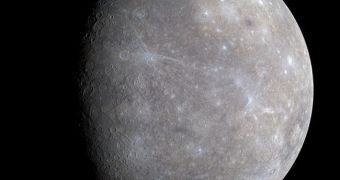Astronomers now propose that Mercury may have been set on its weird orbit by an asteroid impact that occurred a long time ago. The idea came to scientists after noticing that our solar system's innermost planet was not tidally-locked to the Sun.
Such a state can be seen on the Moon, which always keeps the same face oriented towards our planet. If the object were not locked in this manner by massive tidal forces, then it would also revolve around its own axis, like our planet does.
In other words, there are no days or nights on the Moon, but rather a day side and a night side. This state of affairs is produced by the fact that the two objects are located extremely close to each other.
Similarly, astronomers expected to see Mercury tidally-locked to the Sun, considering how close the two objects are close to each other. Instead, what measurements revealed was that the planet is revolving around its own axis three times over the course of two full orbits around the Sun.
This is the equivalent of the planet experiencing three days over the course of two years. The reason why this happens has been puzzling astronomers for many years, and several explanations have been proposed. Yet, none of them could fully account for what happened, Space reports.
Initially, it could be that the planet was indeed tidally locked to the Sun. Astronomers propose that the planet was spinning opposite to the direction it travels in the Sun's orbit. “Mercury once had a spin rate synchronous with the sun, like the moon with the Earth,” researcher Alexandre Correia explains.
The expert, a coauthor on the new study, holds an appointment as a planetary scientist at the University of Aveiro, in Portugal. Correia believes that the asteroid which may have struck Mercury eons ago was around 43 miles (70 kilometers) in diameter.
According to a new series of computer simulations, the space rock was about one 600,000th the mass of the actual planet, or around 550 million metric tons. It could be that the object struck inside the Caloris Basin, a feature on the surface of Mercury that seems the most likely candidate,
The team behind the new work suggests that such an impact may have also been the reason why certain hollows can now be detected inside the surface of Mercury. The formations may have been caused by stored ice that vaporized when the planet stopped being tidally-locked to the Sun.
Details of the new investigation were published in the December 11 online issue of the top journal Nature Geoscience.

 14 DAY TRIAL //
14 DAY TRIAL //